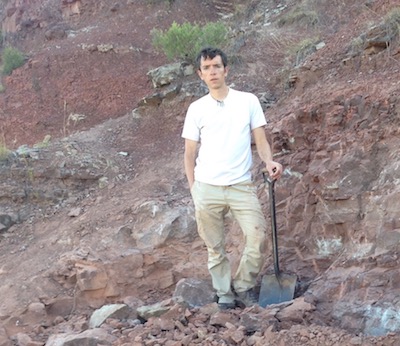 Andrew Moore
Andrew Moore
Assistant Professor
Education
PhD, George Washington University 2018
BA, University of Virginia 2009
Past Positions
Instructor, Stony Brook University (2018-2019)
Email
andrew.j.moore@stonybrook.edu
Links
Google Scholar profile
Research: skeletal pneumaticity; evolution, systematics, and anatomy of sauropod dinosaurs, especially from the Middle-Late Jurassic of East Asia; morphofunctional variation in the axial skeleton
Dr. Drew Moore is an evolutionary anatomist whose research program seeks to understand the functional, ecological, and developmental influences that explain morphological diversity in the vertebrate skeleton. Within this broad purview, his central focus is on pneumatic (i.e., air-filled) postcranial bones and the morphological evolution of lineages that possess them. Although unique to birds among modern tetrapods, postcranial skeletal pneumaticity has its evolutionary origins among non-avian ornithodirans (i.e., pterosaurs + dinosaurs), and results from epithelial extensions of a heterogeneous lung that invade bone and cause the resorption of bone and marrow. The vertebral column is the most commonly pneumatized region of the postcranial skeleton in both living and extinct ornithodirans, and Dr. Moore’s fascination with postcranial skeletal pneumaticity has engendered an abiding interest in morphofunctional variation in the vertebral column more broadly.
Dr. Moore uses phylogenetic analysis, phylogenetic comparative methods, quantitative analysis of models derived from computed tomography (CT) scanning, and geometric morphometrics to test hypotheses about the evolution of the axial skeleton and the soft tissues that shape it, with a particular emphasis on characterizing the interactions between respiratory tissues and the musculoskeletal system. Current research projects in the lab include: morphological description and revisionary systematics of sauropod dinosaurs; identification of new osteological correlates for pneumatic epithelia and other soft tissues; characterization of bauplan-defining allometric trends in the sauropod axial skeleton; and use of micro-CT scanning, digital modelling, and phylogenetic comparative methods to interrogate the functional significance of avian pneumaticity.
Representative publications:
Moore A.J. & Schachner E.R. 2025. When the lung invades: a review of avian postcranial skeletal pneumaticity. Philosophical Transactions of the Royal Society B 380:rstb.2023.0427.
Schachner E.R., Moore A.J., Martinez A., Diaz Jr. R.E., Echols M.S., Atterholt J., Kissane R., Hedrick B.P., & Bates K.T. 2024. The respiratory system influences flight mechanics in soaring birds. Nature 630:671–676.
Moore A.J., Barrett P.M., Upchurch P., Liao C-C., Ye Y., Hao B-Q., & Xu X. 2023. Re-assessment of the Late Jurassic eusauropod Mamenchisaurus sinocanadorum Russell and Zheng, 1993, and the evolution of exceptionally long necks in mamenchisaurids. Journal of Systematic Palaeontology 21:1, 2171818.
Moore A.J. 2021. Vertebral pneumaticity is correlated with serial variation in vertebral shape in storks. Journal of Anatomy 238(3):615–625.

